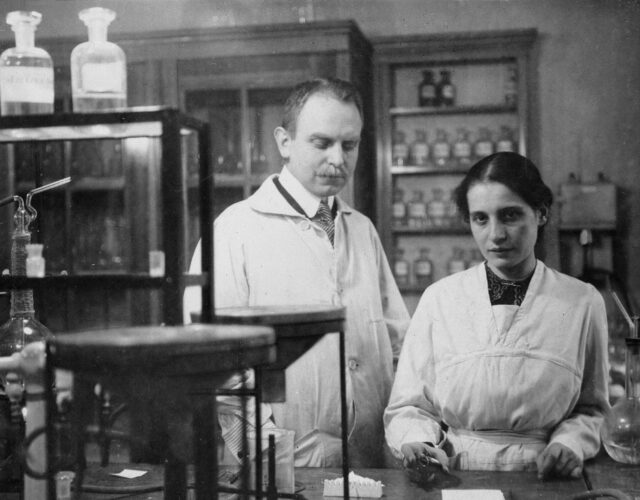In 1904 German chemist Otto Hahn went to England, looking to improve his English and thus his job prospects. Instead the 25-year-old found radioactivity and was quickly seduced by the recently discovered phenomenon. Hahn returned to Germany a few years later as a radiochemist, one who would go on to reveal the alchemy of nuclear fission.
That work would earn him the 1944 Nobel Prize for Chemistry and a postwar platform he would use to oppose nuclear weapons. Like many scientific feats, the discovery of nuclear fission was made with the help of others, including colleagues and close friends, such as Lise Meitner. But after the war Hahn minimized the contributions made by Meitner. Why did he do it—for the pursuit of personal glory or some other reason?
Otto Hahn made his name by discovering a string of radioactive isotopes, first in William Ramsay’s London lab, then with Ernest Rutherford in Montreal, and finally back home in Germany at the University of Berlin. By 1914 the successful radiochemist was newly married and leading the radioactivity department at the recently opened Kaiser Wilhelm Institute for Chemistry in Berlin. Life seemed good. Then World War I broke out.
Hahn was drafted into the Kaiser’s army and put in command of an infantry platoon. Despite this upheaval, the well-traveled chemist found a sort of pleasure in days spent marching through Belgium. It was “like going for a stroll in an occupied country,” he later wrote in his autobiography.
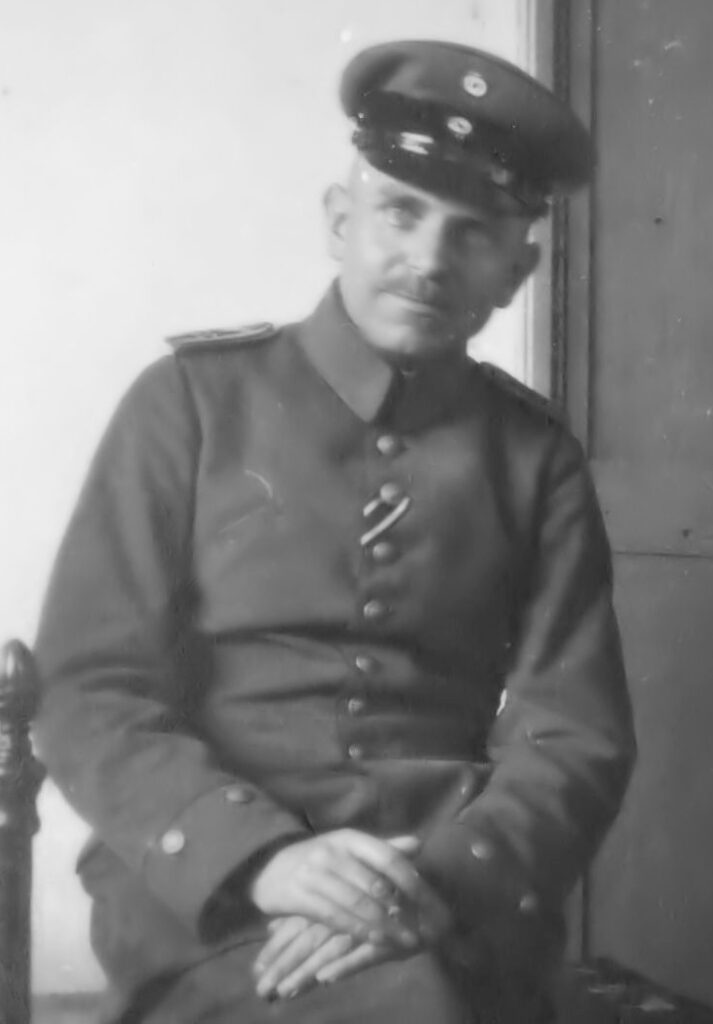
He spent the war’s first Christmas on the front lines, among the soldiers who famously climbed from their trenches to exchange cigarettes and sing carols with their enemies. A few weeks later he was sent to meet fellow chemist Fritz Haber, the head of the Kaiser Wilhelm Institute for Physical Chemistry and Electrochemistry. Haber, a newly made captain, believed poison gas was the key to German victory. At first Hahn objected to the idea of using gas on the battlefield: Haber’s scheme would violate the Hague Convention. But by early July 1915 Hahn had fallen into line and was monitoring poison gas attacks on the Eastern Front, supervising the production of gas canisters in France and Belgium, and, as the gas expert, filling canisters with liquid diphosgene, which had proven to be the deadliest of the gases he’d tested. (Diphosgene and phosgene caused 85% of all deaths by poison gas during World War I.)
While testing gas-mask designs—another of his jobs—Hahn splashed a tiny amount of liquid diphosgene into his eye. Fortunately, prompt medical treatment saved the eye. Hahn was lucky: the following year a colleague died after his mask failed while taking samples from inside a cloud of the gas.
That was just one of many deaths Hahn witnessed. On the Western Front even horses, dogs, and pigeons were outfitted with masks; but in the east the ill-equipped Russians suffered and died from Hahn’s poisonous weapons. Hahn later reflected on the experience in his autobiography.
Early in 1918 Haber told Hahn that the war was lost. The weapon designed to win the war had failed. But that didn’t stop the gas attacks or Hahn’s role in them. Pity and a desire to help could not compete with duty.
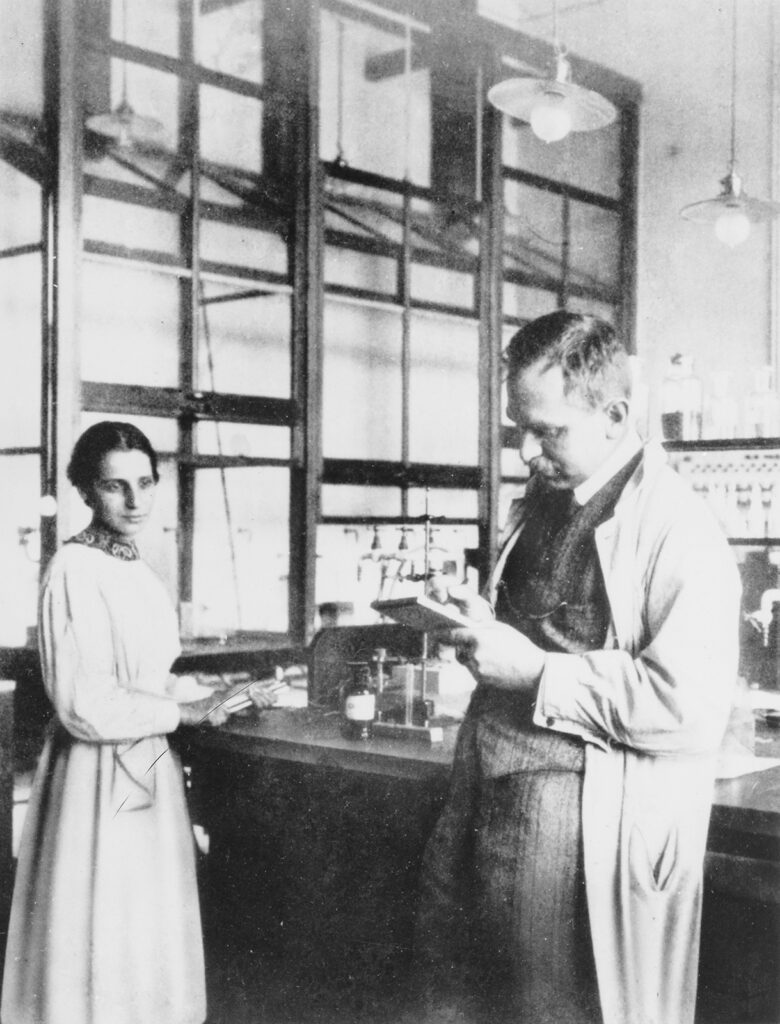
After the war Hahn returned to the Kaiser Wilhelm Institute for Chemistry and his research into the half-lives and decay products of heavy elements. Joining him in that research, as she had for several years before the war, was Austrian physicist Lise Meitner. She had chosen to spend the war as a volunteer X-ray technician with the Austrian military, a safer and morally less troubling job than Hahn’s.
Hahn and Meitner had first started working together in 1907, not long after Hahn’s return to Germany. Their collaboration began with the study of thorium and its radioactive decay. The pair even found time during the war to do some work. In 1918, during Meitner’s leave from operating X-ray machines in an army field hospital, the pair confirmed the existence of a daughter element of uranium, eventually named protactinium.
Their collaboration would last nearly 30 years, and their lifelong friendship would endure challenges in many forms.
Germany’s surrender had left the country politically fractured between right and left. Peace created new problems for its people: a monarch who fled his own country, rising taxes, and a failing currency that for a time required professors and laborers living on fixed salaries to subsist on the cheapest foods—black bread and vegetables. By the end of 1923 inflation was finally under control, but the damage was done. Many Germans had lost faith in their government. Six years later the Great Depression hit Germany. These seeds of discontent were left to grow into National Socialism.
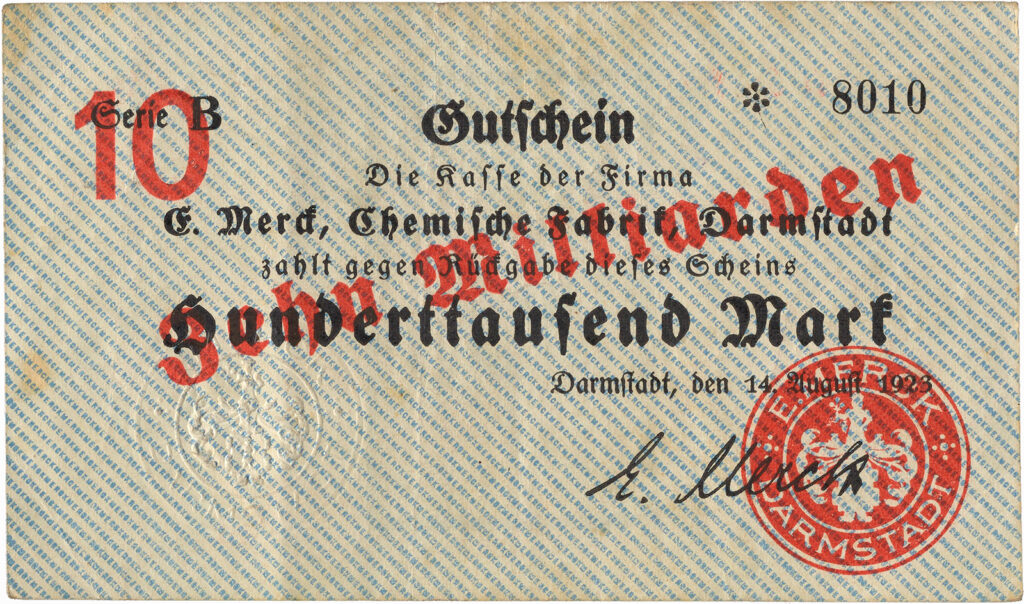
In February 1933, a month after Hitler came to power, Hahn left for the United States—not for any political reasons, but because he had been invited to teach at Cornell University. In his autobiography, published in 1968, Hahn simply remarked, “In 1933 Hitler came to power. For me the year brought the beginning of a new and interesting chapter in my scientific career.”
He soon learned from German Jewish friends in the United States about the Nazi persecution of Jews and Communists. In particular, he discovered German universities were being “cleansed” of Jewish professors and students. By the beginning of April the Nazi Party was organizing a boycott of Jewish businesses. Letters began arriving from Jewish friends in Germany who, according to Hahn, “alluded, with due caution” to plans to leave Germany.
Hahn, like many German scientists outside the Nazi Party, was apolitical. But he was sufficiently disturbed by this “cleansing” to visit the German ambassador in Washington. He hoped to use his status to improve the situation for his Jewish colleagues, at least a little. Hahn described the meeting as cordial, but his visit achieved little. “At least I felt the slight relief of having spoken my mind,” he wrote.
Soon colleagues asked Hahn to return to Germany and help stop the purge of scientists labeled non-Aryan from the civil service. Hahn gathered as many distinguished non-Jewish professors as he could to protest the anti-Semitic Law for the Restoration of the Professional Civil Service. Where an individual had failed, Hahn thought, perhaps a group of elites might now succeed in forcing the Nazi government to back down. Max Planck, Nobel Prize winner and grand old man of German science, had already met with Hitler in a failed attempt to reverse the dismissals. He responded to Hahn’s request with a dose of cold, hard reality. If “thirty professors get up and protest against the government,” Planck replied, “by tomorrow there will be 150 individuals declaring their solidarity with Hitler, simply because they are after the jobs.”
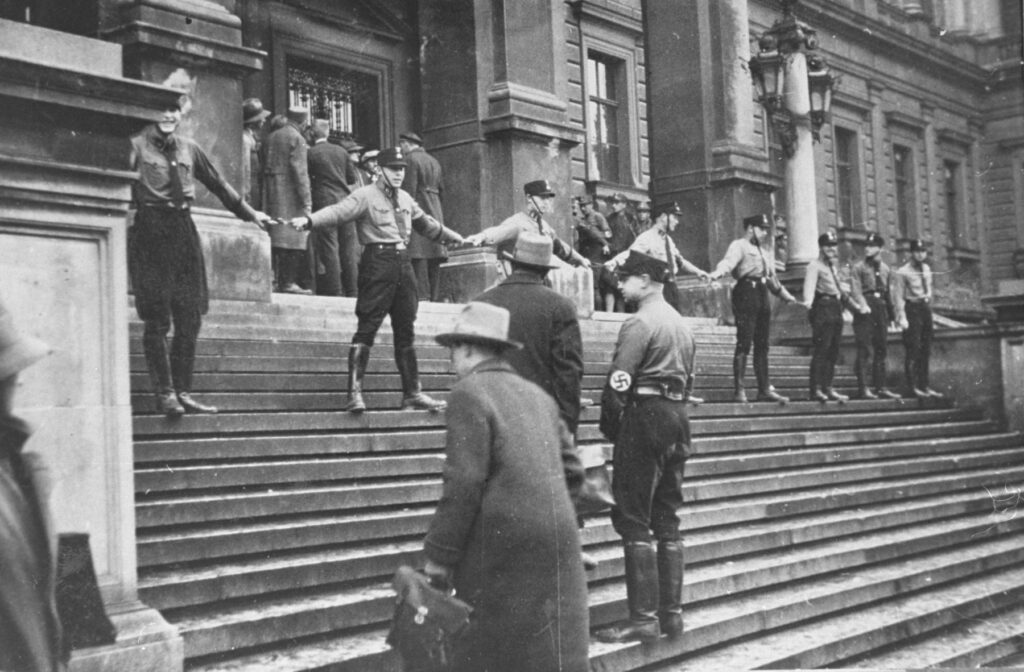
Planck was right. Historian Ute Deichmann also argues that the lack of protests and the “very few signs of sympathy with those dismissed . . . indicate that a second reason, anti-Semitism, played a major role in the attitudes of non-dismissed professors towards their dismissed colleagues.”
The Jewish-born Meitner, as an Austrian citizen, was protected from the worst of the Nazi abuses, although she lost her teaching job at the University of Berlin, one among roughly 200 people fired for their lack of “Aryanness.” She and Hahn remained in charge of their respective areas within the institute, but their two assistants, both members of the Nazi Party, increasingly influenced institute decisions.
In 1934 Hahn’s old boss, Fritz Haber, died in Switzerland. In Germany his death was officially ignored. He had been the only director at the Kaiser Wilhelm Society who refused to dismiss Jewish colleagues. Though exempt from the Nazi purge because of his military service, Haber had chosen to resign in protest rather than fire his colleagues. He asked Hahn to use the institute’s discretionary funds to help those who lost their jobs. A year after Haber’s death a memorial was held for him at the society’s guesthouse. “We did so in defiance of the Ministry’s and the Party’s explicit veto,” Hahn wrote. He spoke of Haber as a colleague and read a speech on Haber’s work written by chemist Karl Friedrich Bonhoeffer, whose two brothers would be hanged during the war for their opposition to the Nazis.
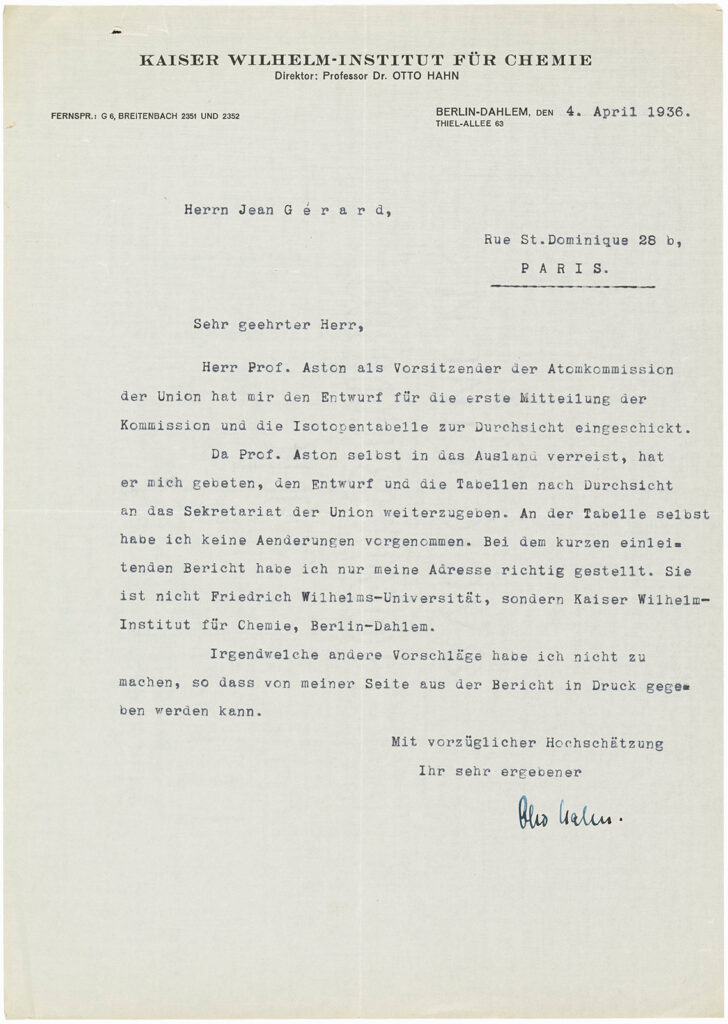
Hahn and Meitner carried on with their research as best they could. In France, Irène and Frédéric Joliot-Curie found they could turn nonradioactive elements into radioactive ones. Soon after, in Italy, Enrico Fermi found that a neutron sent into the nucleus of a uranium atom broke it apart. Could this process produce energy? Ernest Rutherford, nuclear scientist and Hahn’s mentor in Montreal, answered bluntly: “Whoever sees in the transmutation of the atom a source of energy is talking nonsense.” Albert Einstein agreed, though in more polite terms. Meitner and Hahn were intrigued enough by the French and Italian work to start breaking up uranium atoms and studying what was left behind. At least for a while.
In 1938 German soldiers marched into Austria, trampling any protection Meitner’s Austrian passport had afforded her. Nor could she leave Germany. As a well-known scientist, her departure might reflect badly on the country; she might even propagandize against the Nazi regime, worried the ministry official overseeing the Kaiser Wilhelm Institute. The ministry head declared Meitner would stay in Germany, with assurances that no one would bother her.
Such promises were cold comfort. With the safety of his friend and colleague in peril, Hahn took action. Years under Nazi rule had taught him declarations of protest and letter-writing campaigns were futile. Instead he helped arrange Meitner’s escape by train to the Netherlands. Meitner had no visa to enter the Netherlands, but she was accompanied by Dutch physicist Dirk Coster, who was part of a prearranged scheme between the Dutch government and the international physics community. To avoid suspicion, she carried only a small amount of money, 10 marks. Hahn gave her his mother’s diamond ring, to be used in case of urgent need.
On July 13, 1938, after an uneventful trip, Meitner reached the Netherlands and then carried on to Sweden and a new laboratory in Stockholm. Three decades of collaboration with Hahn had ended. Four months later Nazi mobs murdered hundreds of German Jews during the Kristallnacht pogrom.
As the situation worsened in Germany, Hahn continued to update Meitner on the progress of the uranium work. In one letter, he confessed he needed her help. Why, after hitting uranium with neutrons, he wondered, was the expected radium behaving like another element, barium? “Perhaps you can come up with some sort of fantastic explanation,” he wrote. Hahn, it turned out, had unknowingly created nuclear fission. Meitner and her physicist nephew, Otto Frisch, who happened to be visiting her, sat down and calculated how much energy might be released by the process Hahn had discovered. They came up with what appeared to be an impossibly large amount. Word of Meitner and Frisch’s discovery soon passed to England and the United States.
During the war Hahn continued to aid people when he could, at some risk to himself. Together with his wife, he helped a Jewish family escape Germany in 1941. He and a few colleagues continued the uranium work at the Kaiser Wilhelm Institute, investigating what happens when an atom’s nucleus breaks.
As the war ground to an end, British and American intelligence rounded up Hahn and nine other German atomic scientists. The scientists were flown to Great Britain and interned for six months at a country house named Farm Hall, where Allied intelligence secretly recorded the scientists’ conversations, including their reactions to the dropping of the first atom bomb on Japan.
Details about the bomb flummoxed the Germans. Hahn, judging by his own progress, had believed building such a bomb so quickly to be impossible. A colleague named Paul Harteck disagreed, saying that it would have been possible but would require 100 people to work on it, an enormous underestimate given the 120,000 people who worked on the Manhattan Project. (Meitner, for her part, refused to work on the American atom bomb.)
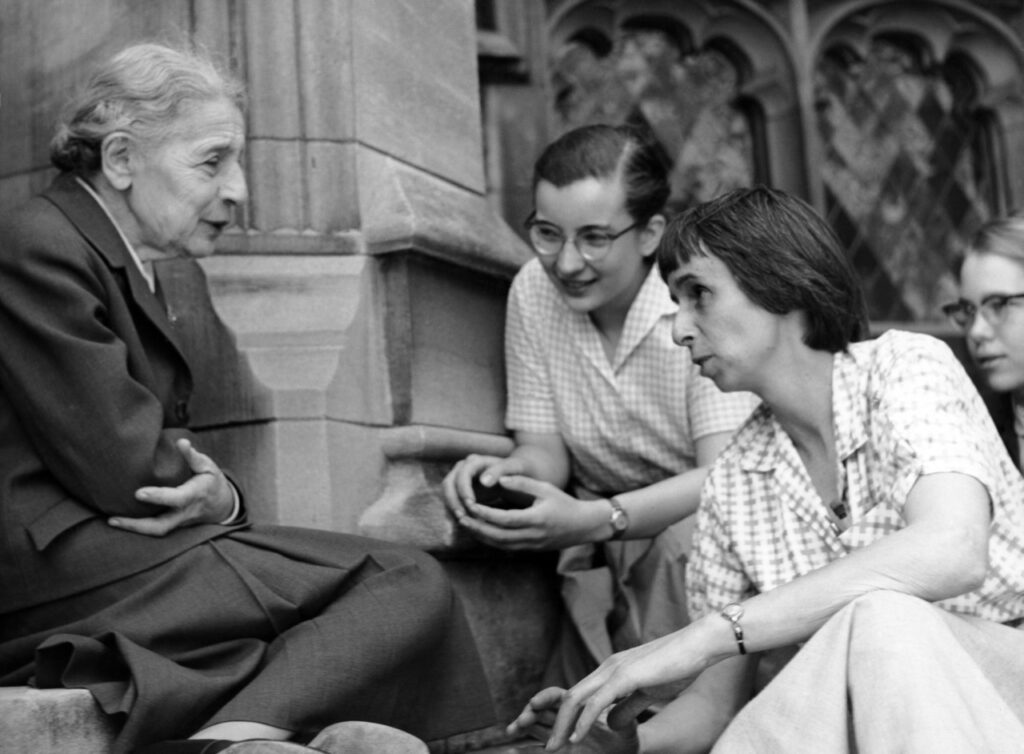
“I want it not to be true,” Hahn wrote in his diary. “I am now glad that we had no way or means of developing a bomb for if it had been possible to build it in Germany during the war one would have been compelled to use it against England. To me that is unthinkable.”
The years of war and destruction weighed on him—his emotions grew so dark that colleagues worried that he might take his life.
Another physicist being held by the English, Carl Friedrich von Weizsäcker, assured his colleagues that the reason Germany did not build a bomb was because German physicists didn’t want to. “If we had all wanted Germany to win the war we would have succeeded.”
“I don’t believe that,” replied Hahn, “but I am thankful we didn’t succeed.”
The 1944 Nobel Prize in Chemistry was awarded to Hahn for his discovery of fission (though he did not receive it until after the war). He gave a portion of the prize money to Meitner, who in turn donated her share to an organization focused on the dangers posed by nuclear weapons.
Hahn came through the war with his personal reputation intact and took leadership of the Max Planck Society, the new incarnation of the Kaiser Wilhelm Society. He became postwar Germany’s grand old man of science.
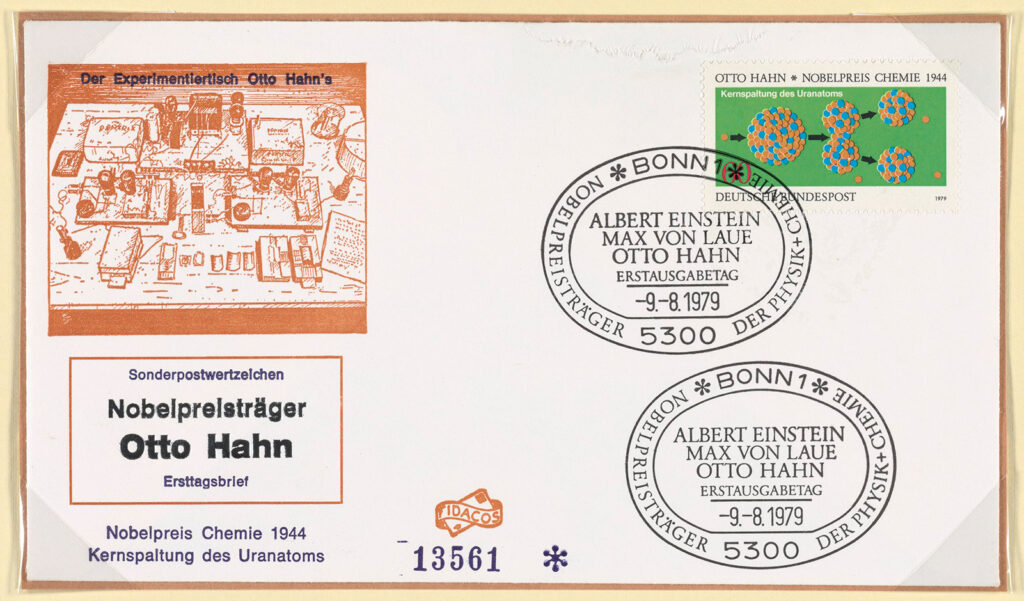
Hahn also rewrote history, putting German science above individual friendship. He claimed Meitner had played no role in the discovery of fission. And despite his personal experiences, he also claimed German science had been unaffected by Nazism.
Meitner biographer Ruth Lewin Sime believes Hahn was building a wall between German science in the Nazi period and postwar period. She writes that after the war Hahn portrayed the Kaiser Wilhelm Society as a “well intentioned, apolitical, purely scientific organization that was beleaguered by an oppressive regime.” This was pure fiction, as Hahn well knew, but his duty to protect and even whitewash the reputation of wartime German science was more important than acknowledging the work of his friend and former colleague.
Meitner realized what Hahn was doing. “He suppresses the past with all his might,” she wrote to a friend, “even though he always truly hated and despised the Nazis. As one of his main motives is to gain international respect for Germany once again, . . . he deceives himself about the facts.”
Perhaps unknowingly, Hahn also deceived others about Meitner. As early as 1946, when Hahn was in Sweden to receive his Nobel, a Swedish newspaper described Meitner as Hahn’s former pupil. In 1953 she gave a public talk in Austria on the future of nuclear energy and its peaceful uses. Newspapers considered the talk worthy of coverage, but not Meitner herself. She was described as Hahn’s assistant.
Meitner had been deeply hurt by Hahn’s dismissal of her work and for a time there was a rift between the two. Yet years of shared experiences drew them back together, though they were careful to avoid subjects that might lead to conflict and distress.

